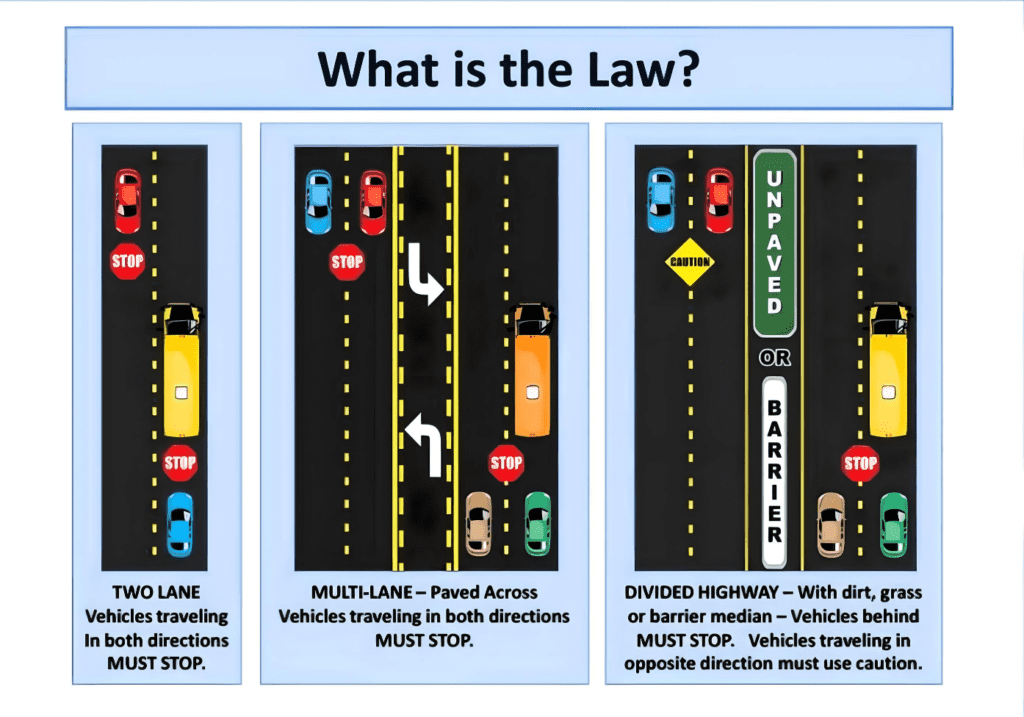National School Bus Safety Week, this year held from October 16-20, is a week-long advocacy campaign designed to highlight school bus safety for teachers, parents, motorists, and students themselves. The campaign, started by the National Association for Pupil Transportation (NAPT), has partnered with thousands of schools across the nation to proliferate resources promoting school bus safety.
According to the National Transportation Safety Board (NTSB), with steel frames designed to absorb impact and well-trained drivers behind the wheel, school buses remain the safest mode of transportation for students. Still, when accidents do occur, an estimated that 30% of those injuries are students themselves.
Busy Streets, Young Lives – School Bus Safety for Commuters and Students
As a responsible commuter, it’s essential to be aware of and adhere to school bus safety rules to protect the precious cargo they carry.
1. Know the Rules: In Georgia, on a two-lane road, vehicles traveling in both directions must stop. On a multi-lane road that is paved across, vehicles traveling in both directions must stop. On a divided highway with dirt, grass or barrier median, vehicles behind the bus must stop.

2. Maintain a Safe Following Distance: When driving behind a school bus, keep a safe following distance. Buses make frequent stops, so maintaining a safe distance ensures you have enough time to stop if the bus suddenly halts to pick up or drop off children.
3. Be Cautious in School Zones: School zones are designated areas with reduced speed limits during certain hours when children are arriving or leaving school. Always obey the posted speed limits and be extra vigilant in school zones – your appointment is not worth a child’s life.
4. Do Not Overtake Stopped Buses – Yes, even when commuting on your bike. Never attempt to pass a school bus that is stopped to pick up or drop off children, even if you think you can do so safely. Three percent of school-bus accident fatalities are bicyclists or pedestrians.
5. Be Patient!: School buses make frequent stops and may drive slower than other traffic. Remember that the safety of children on board is the top priority, so be patient and courteous when sharing the road with buses.
6. Use Extra Caution in Inclement Weather: Georgia weather can be unpredictable, especially in these fall and winter months when kids are just returning to their school routine. In bad weather, exercise even more caution when driving near school buses. Reduced visibility and slippery roads can make it more challenging to stop in time.
Empower Your Students and Kids!
It’s essential for students to play an active role in their own safety while waiting for, and riding, the school bus. Communicate to your kids that these tips will help you stay safe on the school bus.
1. Arrive Early: Make sure you arrive at your bus stop a few minutes before the scheduled pick-up time. Rushing to catch the bus can lead to accidents or missed pickups.
2. Wait Safely: While waiting for the bus, stand at least five giant steps (or about 6 feet) away from the edge of the road. This distance ensures that the bus driver can see you and that you won’t accidentally step into traffic.
3. Line Up Quietly: When the bus arrives, form a line and wait your turn to board. Pushing and shoving can lead to falls and injuries.
4. Enter and Exit Safely: Use the handrail and take one step at a time when boarding and exiting the bus. Always wait for the driver’s signal before crossing in front of the bus, ensuring that they can see you.
5. Find a Seat Quickly: Once on the bus, find a seat and sit down. Avoid standing or moving around while the bus is in motion. Sit facing forward and keep the aisle clear of backpacks and other belongings to prevent tripping hazards.
6. Be Respectful: Always be respectful to your bus driver and fellow passengers. Follow instructions promptly and avoid loud or disruptive behavior that could distract the driver.
7. Keep Noise Levels Down: Excessive noise can distract the driver, making it difficult to concentrate on the road. Keep conversations and noise levels at a reasonable volume.
8. Stay Seated: Stay seated while the bus is moving. If the bus has seat belts, make sure to fasten them. This added safety measure can protect you in the event of sudden stops or accidents.
9. Emergency Procedures: Familiarize yourself with the emergency exits and evacuation procedures on the bus. While rare, knowing what to do in an emergency can save lives.
10. No Bullying: Bullying on the bus (or anywhere!) is not acceptable. Treat your fellow students with kindness and respect. If you witness bullying, report it to a trusted adult.
11. Keep Personal Belongings to Yourself: Hold onto your belongings and make sure they are safely stowed to prevent them from falling or blocking the aisle.
12. Exit Safely: Wait for the bus to come to a complete stop before standing up and exiting.
13. And for classroom posters and more tips, download our National School Bus Safety Week toolkit today!
Commuters and students alike contribute to a safe environment. Remember that safety is a shared responsibility, and it’s crucial to play your part in ensuring a safe journey to and from school every day.
